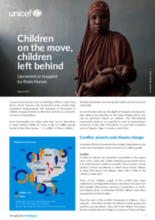This article discusses the major population displacement that unfolded in Africa’s Lake Chad Basin. Local communities have offered shelter to 2.6 million people who were forced to leave their homes. This document discusses how the international community needs to act immediately to scale up humanitarian assistance in the Lake Chad Basin region.
Factors that have added to the complexity of the humanitarian crisis in the Lake Chad region include ongoing violence and conflict since 2013, poverty, and climate change. Many children have been reported to be a part of the conflict to the point that they are subjected to extreme violence and abuse. This report estimates that one out of four suicide bombers in the region are children. Communities in the region are among the poorest in the world. Climate change has reduced the size of Lake Chad, the region’s largest water reservoir by nearly 10 times.
This article discusses the nutrition crisis the region faces, stating that more than 475,000 children in the area are expected to suffer from severe acute malnutrition. The article points out that the defining feature of this crisis is how neighboring communities have taken in people from the conflict torn region.
This article includes a call to action stating that the Lake Chad crisis is a children’s crisis that should rank high on the global migration and displacement agenda. According to this article, children are fleeing violence are facing multiple risks from violence and exploitation. This report points out that as the needs of the children displaced and suffering from this crisis continue to grow, the crisis remains underfunded. UNICEF has revised its funding needs to US$ 308 million. As of mid-August 2016, UNICEF had only received US$41.2 million.

